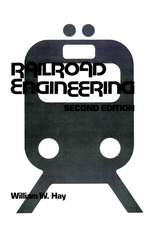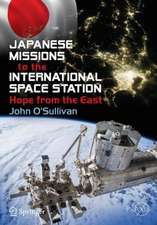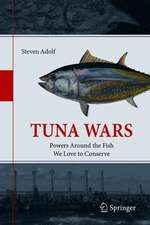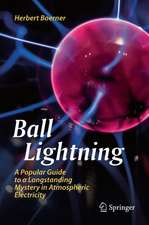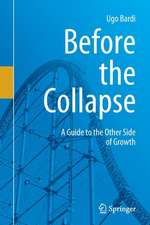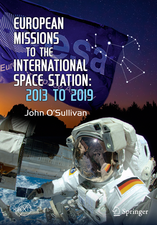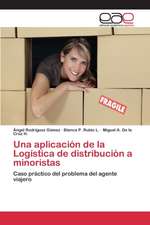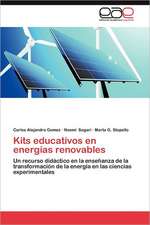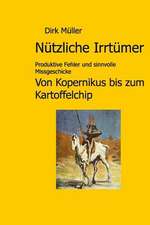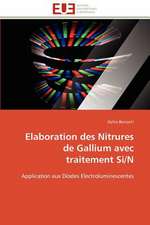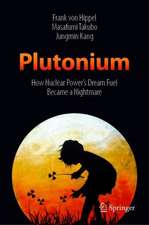Experimenting on a Small Planet: A History of Scientific Discoveries, a Future of Climate Change and Global Warming
Autor William W. Hayen Limba Engleză Paperback – 29 sep 2022
| Toate formatele și edițiile | Preț | Express |
|---|---|---|
| Paperback (2) | 381.02 lei 22-36 zile | +103.70 lei 6-12 zile |
| Springer International Publishing – 29 sep 2022 | 381.02 lei 22-36 zile | +103.70 lei 6-12 zile |
| Springer International Publishing – 26 mai 2018 | 1332.14 lei 22-36 zile | |
| Hardback (2) | 566.92 lei 38-44 zile | |
| Springer International Publishing – 28 sep 2021 | 566.92 lei 38-44 zile | |
| Springer International Publishing – 10 iun 2016 | 567.84 lei 38-44 zile |
Preț: 381.02 lei
Nou
Puncte Express: 572
Preț estimativ în valută:
72.93€ • 79.25$ • 61.30£
72.93€ • 79.25$ • 61.30£
Carte disponibilă
Livrare economică 31 martie-14 aprilie
Livrare express 15-21 martie pentru 113.69 lei
Preluare comenzi: 021 569.72.76
Specificații
ISBN-13: 9783030763411
ISBN-10: 3030763412
Pagini: 1001
Ilustrații: XVI, 1001 p. 780 illus., 479 illus. in color.
Dimensiuni: 210 x 279 x 63 mm
Greutate: 2.24 kg
Ediția:3rd ed. 2021
Editura: Springer International Publishing
Colecția Springer
Locul publicării:Cham, Switzerland
ISBN-10: 3030763412
Pagini: 1001
Ilustrații: XVI, 1001 p. 780 illus., 479 illus. in color.
Dimensiuni: 210 x 279 x 63 mm
Greutate: 2.24 kg
Ediția:3rd ed. 2021
Editura: Springer International Publishing
Colecția Springer
Locul publicării:Cham, Switzerland
Cuprins
Chapter 1. Introduction.- Chapter 2. Discovering Climate.- Chapter 3. The Language of Science.- Chapter 4. Applying Mathematics to Problems.- Chapter 5. Geologic Time.- Chapter 6. Putting Numbers on Geologic Ages.- Chapter 7. Documenting Past Climate Change.- Chapter 8. The Nature of Energy Received From the Sun – The Analogies with Water Waves and Sound.- Chapter 9. The Nature of Energy Received From the Sun---Figuring Out What Light Really Is.- Chapter 10. Exploring the Electromagnetic Spectrum.- Chapter 11. The Origins of Climate Science---The Idea Of Energy Balance.- Chapter 12. The Climate System.- Chapter 13. What’s At The Bottom of Alice’s Rabbit Hole.- Chapter 14. Energy from the Sun---Long-Term Variations.- Chapter 15. Solar Variability and Cosmic Rays.- Chapter 16. Albedo.- Chapter 17. Air.- Chapter 18. HOH---The Keystone Of Earth’s Climate.- Chapter 19. The Atmosphere.- Chapter 20. Oxygen and Ozone---Products and Protectors of Life.- Chapter 21. Water Vapor---The MajorGreenhouse Gas.- Chapter 22. Carbon Dioxide.- Chapter 23. Other Greenhouse Gases.- Chapter 24. The Earth Is a Sphere and Rotates.- Chapter 25. The Coriolis Effect.- Chapter 26. The Circulation of Earth’s Atmosphere.- Chapter 27. The Circulation of Earth’s Oceans.- Chapter 28. The Biological Interactions.- Chapter 29. Sea Level.- Chapter 30. Global Climate Change---The Geologically Immediate Past.- Chapter 31. Human Impacts on the Environment and Climate.- Chapter 32. Predictions of the Future of Humanity.- Chapter 33. Is there an Analog for the Future Climate.- Chapter 34. The Instrumental Temperature Record.- Chapter 35. The Changing Climate of the Polar Regions.- Chapter 36. Global, Regional and Local Effects of Our Changing Climate.- Chapter 37. Final Thoughts.
Notă biografică
William W. (Bill) Hay was born October 12, 1934, in Dallas, Texas. He received his B.S. in Biology from Southern Methodist University in 1955, M.S. in Geology from the University of Illinois at Urbana in 1958, and Ph.D. in Geology from Stanford University in 1960. As an undergraduate and graduate student he also studied at Ludwig-Maximillian's University in Munich under Wayne University's "Junior Year in Munich" program, and the University of Zurich as a Fellow of the Swiss Friends of the USA.
After a year of postdoctoral study at the University of Basel, Switzerland, he began his professional career at the University of Illinois in Urbana in 1960. In 1968 he become a joint Professor of Geology at the University of Illinois and Professor of Marine Geology and Geophysics at the Rosenstiel School of Marine and Atmospheric Sciences (RSMAS) of the University of Miami. He maintained this joint arrangement until 1974. From 1974-76 he served as Chairman of the Division of Marine Geology and Geophysics, and from 1976-1980 as Dean of RSMAS. From 1979 to 1982 he served as President of Joint Oceanographic Institutions, Inc. in Washington, D.C.
In 1982 he moved to Boulder, Colorado as Director of the University Museum, and was soon added to the faculty of Geology and CIRES. He resigned as Director of the Museum in 1987, and from 1990 to 1998 was on a half -time appointment at Colorado and half-time as Gastprofessor at GEOMAR, a marine geological research institute attached to Christian-Albrecht's-Universität, Kiel, Germany. In 1991-92 he was an Alexander von Humboldt Senior Research Scientist. In the summer of 1993 he was Gastprofessor in the Sektion Marine Geologie, Institute for Baltic Sea Research in Warnemünde, Germany, and in the fall of the same year F. C. Donders Professor at the Institute of Earth Sciences, University of Utrecht, The Netherlands. In the fall of 1995 and again in 2010 he was Gastprofessor, sponsored by the University of Vienna, in the University's Institut für Paläontologie, Vienna, Austria. During the fall of 1996 he was Gastwissenschaftler, sponsored by the Deutsche Forschungsgemeinschaft, at the Institute for Baltic Sea Research in Warnemünde/Rostock and Gastprofessor at Ernst-Moritz-Arndt University in Greifswald, Germany. During the summer and fall of 1997 he was Gastprofessor at GEOMAR, Christian-Albrecht's-University, Kiel, Germany. He retired from the University of Colorado in 1998 to take on the role of Professor of Paleoceanology full time at GEOMAR. He retired from GEOMAR in June 2002. He is Professor Emeritus at the University of Colorado, and now lives in Estes Park, Colorado. In 2018 he was awarded an Honorary Doctorate (Doktor der Naturwissenschaften Ehrenhaber) from Christian-Albrecht’s University in Kiel.
His current special interests are in global paleoclimatic and paleoceanographic modeling; paleoclimate model verification; geological mass balance for the global sedimentation system;modelling tectonics, erosion and sedimentation; topographic and bathymetric effects on climate and oceanography; global plate tectonic reconstructions; global paleogeography; geomaterial fluxes; global carbon cycle.
His is author or co-author of more than 260 scientific papers.
He has served on the Ocean Sciences Board of the US National Research Council, the Advisory Committee of the Division of Ocean Sciences of the US National Science Foundation, the Board of the Gulf and Caribbean Fisheries Institute, a number of JOIDES (Joint Oceanographic institutions for Deep Earth Sampling) panels and committees, the Scientific Committee on Oceanographic Research (SCOR), and has been a Trustee of the International Oceanographic Foundation.
His involvement with ocean drilling goes back to the SUBMAREX (1963), where he was one of the investigators of the paleontology of the cores. He was a reviewer of the LOCO and JOIDES proposals. He served on the JOIDES Gulf Advisory Panel, from1965-74. After moving part time to the Rosenstiel School of the University of Miami he became that institution’s
representative on the JOIDES Planning Committee serving from 1968-76, and serving as Chairman from 1972-74, when the internationalization and expansion of JOIDES took place. During the DSDP era, he also served on the Paleontology and Biostratigraphy Panel (1968-75), the Atlantic Advisory Panel (1970-73), the Advisory Panel on Pollution Prevention and Safety (1972-74), the Advisory Panel on Organic Geochemistry (1972-76), and the Advisory Panel on Ocean Paleoenvironment, 1973-76. He was alternate to Warren Wooster on the JOIDES Executive Committee in 1975-76, and served as a member of the Executive Committee from 1976-80. He participated on Legs 4, 15, and 75 of the DSDP, serving as a co-chief scientist on Leg 75.
He was largely responsible for establishment of JOI, Inc. (Joint Oceanographic Institutions) as the legally responsible agent for ocean drilling, clarifying the liability questions associated with JOIDES. He served on the JOI Board of Governors from 1976-80 and was its Vice Chairman from 1978-80. When the Office of Science and Technology Policy pressed exploration of an academic/industry joint venture for drilling the ocean margins with riser capabilities, he was selected to serve as Chairman of the Scientific Advisory Committee for the Ocean Margin Drilling Program from 1979-1986. To enhance the visibility of the science program he became President of JOI, and served in that capacity from 1979-1982.
He served as Chairman of a National Science Foundation - Division of Ocean Sciences Panel to Review the Ocean Drilling Program in 1988. He has also served on JOI Committees to review ODP.
In a related role, he served as Chairman of the National Academy of Sciences/National Research Council's Continental Scientific Drilling Committee from 1985-88.
In the Ocean Drilling program phase, he has served on the Advisory Panel on Sediment and Ocean History (1984-87) and the Advisory Panel on Sedimentary Geochemistry and Physical Processes from 1989-92 and again from1994-97, when he served as its Chairperson. He participated in JOI/USSAC Workshops on Scientific Drilling in the South Atlantic (1985), Scientific Drilling in the Caribbean (1986), Global Changes in Sea Level (Steering Committee, 1987-90), Ocean Chemistry (1990), and Paleogene Paleoceanography (1991). He also served on the JOIDES Scientific Advisory Structure Review Committee (1992-93), and as Chairman of a Detailed Planning Group on Antarctic Ocean Drilling in 1996. He served as the German representative on the JOIDES Scientific Committee from 1998-2001, and as its Chairman for 1999-2000. He participated in the formation of ECOD, the European Consortium for Ocean Drilling.
After a year of postdoctoral study at the University of Basel, Switzerland, he began his professional career at the University of Illinois in Urbana in 1960. In 1968 he become a joint Professor of Geology at the University of Illinois and Professor of Marine Geology and Geophysics at the Rosenstiel School of Marine and Atmospheric Sciences (RSMAS) of the University of Miami. He maintained this joint arrangement until 1974. From 1974-76 he served as Chairman of the Division of Marine Geology and Geophysics, and from 1976-1980 as Dean of RSMAS. From 1979 to 1982 he served as President of Joint Oceanographic Institutions, Inc. in Washington, D.C.
In 1982 he moved to Boulder, Colorado as Director of the University Museum, and was soon added to the faculty of Geology and CIRES. He resigned as Director of the Museum in 1987, and from 1990 to 1998 was on a half -time appointment at Colorado and half-time as Gastprofessor at GEOMAR, a marine geological research institute attached to Christian-Albrecht's-Universität, Kiel, Germany. In 1991-92 he was an Alexander von Humboldt Senior Research Scientist. In the summer of 1993 he was Gastprofessor in the Sektion Marine Geologie, Institute for Baltic Sea Research in Warnemünde, Germany, and in the fall of the same year F. C. Donders Professor at the Institute of Earth Sciences, University of Utrecht, The Netherlands. In the fall of 1995 and again in 2010 he was Gastprofessor, sponsored by the University of Vienna, in the University's Institut für Paläontologie, Vienna, Austria. During the fall of 1996 he was Gastwissenschaftler, sponsored by the Deutsche Forschungsgemeinschaft, at the Institute for Baltic Sea Research in Warnemünde/Rostock and Gastprofessor at Ernst-Moritz-Arndt University in Greifswald, Germany. During the summer and fall of 1997 he was Gastprofessor at GEOMAR, Christian-Albrecht's-University, Kiel, Germany. He retired from the University of Colorado in 1998 to take on the role of Professor of Paleoceanology full time at GEOMAR. He retired from GEOMAR in June 2002. He is Professor Emeritus at the University of Colorado, and now lives in Estes Park, Colorado. In 2018 he was awarded an Honorary Doctorate (Doktor der Naturwissenschaften Ehrenhaber) from Christian-Albrecht’s University in Kiel.
His current special interests are in global paleoclimatic and paleoceanographic modeling; paleoclimate model verification; geological mass balance for the global sedimentation system;modelling tectonics, erosion and sedimentation; topographic and bathymetric effects on climate and oceanography; global plate tectonic reconstructions; global paleogeography; geomaterial fluxes; global carbon cycle.
His is author or co-author of more than 260 scientific papers.
He has served on the Ocean Sciences Board of the US National Research Council, the Advisory Committee of the Division of Ocean Sciences of the US National Science Foundation, the Board of the Gulf and Caribbean Fisheries Institute, a number of JOIDES (Joint Oceanographic institutions for Deep Earth Sampling) panels and committees, the Scientific Committee on Oceanographic Research (SCOR), and has been a Trustee of the International Oceanographic Foundation.
His involvement with ocean drilling goes back to the SUBMAREX (1963), where he was one of the investigators of the paleontology of the cores. He was a reviewer of the LOCO and JOIDES proposals. He served on the JOIDES Gulf Advisory Panel, from1965-74. After moving part time to the Rosenstiel School of the University of Miami he became that institution’s
representative on the JOIDES Planning Committee serving from 1968-76, and serving as Chairman from 1972-74, when the internationalization and expansion of JOIDES took place. During the DSDP era, he also served on the Paleontology and Biostratigraphy Panel (1968-75), the Atlantic Advisory Panel (1970-73), the Advisory Panel on Pollution Prevention and Safety (1972-74), the Advisory Panel on Organic Geochemistry (1972-76), and the Advisory Panel on Ocean Paleoenvironment, 1973-76. He was alternate to Warren Wooster on the JOIDES Executive Committee in 1975-76, and served as a member of the Executive Committee from 1976-80. He participated on Legs 4, 15, and 75 of the DSDP, serving as a co-chief scientist on Leg 75.
He was largely responsible for establishment of JOI, Inc. (Joint Oceanographic Institutions) as the legally responsible agent for ocean drilling, clarifying the liability questions associated with JOIDES. He served on the JOI Board of Governors from 1976-80 and was its Vice Chairman from 1978-80. When the Office of Science and Technology Policy pressed exploration of an academic/industry joint venture for drilling the ocean margins with riser capabilities, he was selected to serve as Chairman of the Scientific Advisory Committee for the Ocean Margin Drilling Program from 1979-1986. To enhance the visibility of the science program he became President of JOI, and served in that capacity from 1979-1982.
He served as Chairman of a National Science Foundation - Division of Ocean Sciences Panel to Review the Ocean Drilling Program in 1988. He has also served on JOI Committees to review ODP.
In a related role, he served as Chairman of the National Academy of Sciences/National Research Council's Continental Scientific Drilling Committee from 1985-88.
In the Ocean Drilling program phase, he has served on the Advisory Panel on Sediment and Ocean History (1984-87) and the Advisory Panel on Sedimentary Geochemistry and Physical Processes from 1989-92 and again from1994-97, when he served as its Chairperson. He participated in JOI/USSAC Workshops on Scientific Drilling in the South Atlantic (1985), Scientific Drilling in the Caribbean (1986), Global Changes in Sea Level (Steering Committee, 1987-90), Ocean Chemistry (1990), and Paleogene Paleoceanography (1991). He also served on the JOIDES Scientific Advisory Structure Review Committee (1992-93), and as Chairman of a Detailed Planning Group on Antarctic Ocean Drilling in 1996. He served as the German representative on the JOIDES Scientific Committee from 1998-2001, and as its Chairman for 1999-2000. He participated in the formation of ECOD, the European Consortium for Ocean Drilling.
Textul de pe ultima copertă
This book is a thorough introduction to climate science and global change. The author is a geologist who has spent much of his life investigating the climate of Earth from a time when it was warm and dinosaurs roamed the land, to today's changing climate. Bill Hay takes you on a journey to understand how the climate system works. He explores how humans are unintentionally conducting a grand uncontrolled experiment which is leading to unanticipated changes. We follow the twisting path of seemingly unrelated discoveries in physics, chemistry, biology, geology, and even mathematics to learn how they led to our present knowledge of how our planet works. He explains why the weather is becoming increasingly chaotic as our planet warms at a rate far faster than at any time in its geologic past. He speculates on possible future outcomes, and suggests that nature itself may make some unexpected course corrections. Although the book is written for the layman with little knowledge of science or mathematics, it includes information from many diverse fields to provide even those actively working in the field of climatology with a broader view of this developing drama. Experimenting on a Small Planet is a must read for anyone having more than a casual interest in global warming and climate change - one of the most important and challenging issues of our time. This new edition includes actual data from climate science into 2021. Numerous Powerpoint slides can be downloaded to allow lecturers and teachers to more effectively use the book as a basis for climate change education.
Caracteristici
Explains the many aspects of climate science in easily accessible stories New edition with up-to-date science Powerpoint slides for each chapter provide perfect teaching basis
Recenzii
Selected by Choice magazine as an Outstanding Academic Title for 2017
“In this title, Hay (emer., Univ. of Colorado) has extraordinarily combined science, art, and humor to provide a thorough, accessible account of the history of climate science. … The scope and presentation style make this a recommended title for experts interested in learning more outside of their areas of knowledge, students interested in a nontechnical perspective on climate science, or general readers seeking reliable climate science information. … Summing Up: Highly recommended. All readers.” (J. Schoof, Choice, Vol. 54 (5), January, 2017)

